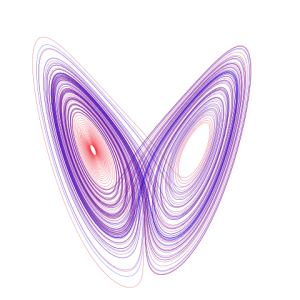[Feature photo above: Clifford Attractor by Yami89 (public domain) via Wikimedia Commons.]
Alexandria Jones collapsed onto the couch with a dramatic sigh. Her father, the world-famous archaeologist Dr. Fibonacci Jones, glanced up from his newspaper and rolled his eyes.
“I don’t even want to hear about it,” he said.
Alex’s brother Leonhard was playing on the floor, making faces at the baby. He looked up at Alex and grinned.
“I’ll take the bait,” he said. “What happened?”
“Mom called my bedroom a Strange Attractor.”
“Oh? What does it attract?”
“I don’t know. Mostly books and model horses. But what’s so strange about that?”
The Mathematics of Chaos

Dr. Jones laughed and put down his paper. “Strange attractor is a technical term from the branch of mathematics called dynamical systems analysis — often called chaos theory.”
“So my bedroom is a math problem?”
“No. I think Mom meant your bedroom was chaos.”
“Oh.” Alex looked like she might pout, then she shrugged. “I guess she’s right, at that. So what is a strange attractor, really?”
“Well, when scientists first drew graphs of classical, non-chaotic systems — like a planet’s orbit or the flight of a football — it was surprising how often they got an ellipse or parabola or some similar curve,” Dr. Jones explained. “For some reason, nature seemed to be attracted to the shapes of classical geometry.”
What Is a Strange Attractor?

“Like bushes are spheres and mountains are pyramids?” Alex asked. “But they aren’t really — not even very close.”
He shook his head. “Neither does a football fly in an exact parabola, nor a planet orbit in an exact ellipse. But those two examples are close enough that we can predict their motion and send a man to the moon.”
“Classical geometry made science easy to understand,” Dr. Jones continued. “And it worked fairly well, until scientists tried to graph dynamical systems like the weather or an earthquake or the growth of a tree…”
Leon jumped up. “I know! Then they get a mess like Alex’s bedroom, right?”
“Not quite. Chaotic systems tend to hover around certain values in a complicated, fractal pattern. That fractal pattern is called the system’s strange attractor.”
A Problem with Words

Alex frowned. “But doesn’t chaos theory mean that everything in the universe comes from a chaotic jumble of energy left over from the Big Bang? And that we can’t really know anything, because it’s all chaos?”
“Yeah,” Leon said. “Chaos theory says that God isn’t really in charge of the universe — that everything happens by chance.”
“Watch out,” Dr. Jones warned. “You are both falling into a common fallacy.”
“Huh?” Leon said.
Alex nudged him with her elbow. “Fallacy means a mistake in logic.”
Dr. Jones nodded. “You are confusing two logically different ideas, just because they both use the word chaos. What chaos theory says is that some things are so complicated scientists will never be able to predict them. That is not the same as saying the universe is ruled by chaos, or that God himself cannot understand or control things.”
Don’t Confuse Physics and Metaphysics

“Do you know the difference between physics and metaphysics?” Dr. Jones asked.
“Hmmm,” Alex said. “Physics is the study of how the universe works. Matter and energy and gravitation and stuff like that.”
“Right,” her father said. “Then you could say that metaphysics is the study of why the universe works. Physics works with things you can measure. But metaphysics deals with things that are impossible to measure.”
“I know,” Leon said. “What God is like, or how people are different from animals.”
“Those are just a couple of questions that metaphysics might try to answer,” Dr. Jones said. “Now, you see, your fallacy was to confuse the two. Chaos theory has to do with physics — with the world we can touch and measure. But the statement ‘Everything is chaos’ is a metaphysical statement. There is no way a scientist could measure or prove something like that.”
“Oh, I get it,” Alex said. “It’s like the difference between relativity and relativism.”
“What do you mean?” Leon asked. “Relativity is about warp speed, right?”
Alex laughed. “Warp speed is science fiction. Relativity means things look different from different angles, sort of. And that nothing can go faster than the speed of light. Albert Einstein discovered it.”
“So what is relativism?”
“Relativism says that there isn’t any true right or wrong,” Alex explained. “That means values are relative, and you can do whatever you want.”
“Exactly,” Dr. Jones said. “The problem is, many people think that Einstein’s Theory of Relativity proved that relativism is true. They are confusing physics with metaphysics. As I said, it’s a common fallacy.”
To Be Continued…
Read all the posts from the January/February 2000 issue of my Mathematical Adventures of Alexandria Jones newsletter.

I just want to thank you for this awesome series! It has helped ME understand so much and also made heavy concepts easier for my kids to comprehend. Thank you for sharing your wisdom and world view with us!
Thanks for the encouraging words, Karah. I’m glad you’re enjoying my blog.